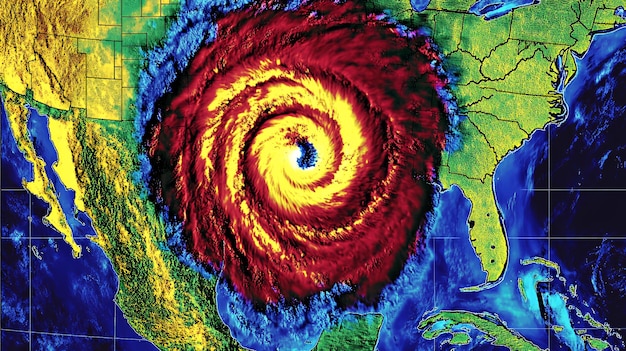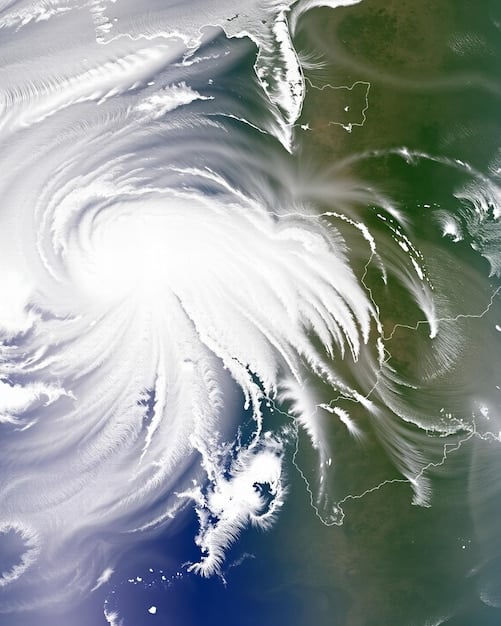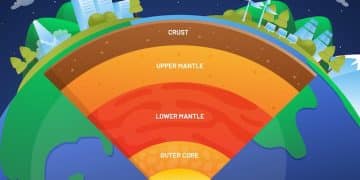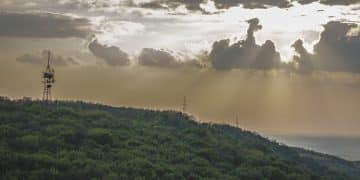The Science Behind Extreme Weather: Frequent, Intense Events in US Unpacked

Advertisements
The escalating frequency and intensity of extreme weather events across the U.S. are directly linked to human-induced climate change, with scientific consensus highlighting increased global temperatures, altered atmospheric circulation, and shifts in hydrological cycles as primary drivers.
Advertisements
The United States has recently experienced a noticeable uptick in severe weather phenomena, leading to widespread disruption and significant public concern. Understanding The Science Behind Extreme Weather: What’s Causing More Frequent and Intense Events Across the US? is paramount for effective mitigation and adaptation strategies, moving beyond anecdotal observations to scientific causality.
Understanding the Climate Change Nexus
Delving into the mechanisms driving more frequent and intense extreme weather events across the United States requires a fundamental understanding of how climate change is altering Earth’s systems. It’s not merely a matter of warmer temperatures, but a complex interplay of atmospheric, oceanic, and terrestrial responses to increased greenhouse gas concentrations. The scientific community has largely converged on the robust conclusion that human activities are the predominant factor behind these shifts.
Advertisements
The primary culprit is the enhanced greenhouse effect, caused by the emission of gases like carbon dioxide, methane, and nitrous oxide from industrial processes, fossil fuel combustion, and agriculture. These gases trap heat in the Earth’s atmosphere, leading to a rise in global average temperatures. This warming doesn’t uniformly increase all temperatures; rather, it provides more energy to the climate system, fueling more powerful and unpredictable weather patterns.
The Role of Rising Global Temperatures
A warmer atmosphere holds more moisture. For every additional degree Celsius of warming, the atmosphere can hold approximately 7% more water vapor. This increased moisture content is a critical factor in the intensification of many extreme weather events, particularly heavy rainfall and snow events. When storms do form, they have a greater reservoir of moisture to draw upon, leading to more extreme precipitation rates.
- Increased Evaporation: Warmer temperatures accelerate evaporation from oceans, lakes, and soils.
- Enhanced Water Vapor: More water vapor in the atmosphere provides fuel for intense storms.
- Higher Dew Points: Elevated dew points indicate more moisture, contributing to higher heat indices.
- Melting Ice and Snow: Contributes to sea level rise and changes in ocean circulation.
Furthermore, rising temperatures directly contribute to stronger heatwaves. Prolonged periods of unusually high temperatures can have severe impacts on human health, agriculture, and infrastructure. The duration, intensity, and geographical extent of heatwaves are increasing across many parts of the U.S., making extreme heat a growing public health concern.
The warming also extends to ocean temperatures. Warmer ocean waters provide more energy for tropical cyclones (hurricanes and typhoons), increasing their potential intensity and the rate at which they can strengthen. While the overall number of tropical cyclones might not uniformly increase, the proportion of the most powerful storms (Category 4 and 5) is projected to rise.
The connection between rising global temperatures and extreme weather is multifaceted. It involves not only the direct thermal effects but also the cascading impacts on atmospheric circulation patterns, ocean currents, and the hydrological cycle, creating a volatile and less predictable climate system. This enhanced energy within the system manifests as the more frequent and intense events observed across the U.S.
Atmospheric Circulation and Jet Stream Abnormalities
Beyond the direct warming effect, a crucial aspect of understanding modern extreme weather is the way climate change appears to be influencing large-scale atmospheric circulation patterns, particularly the jet stream. The jet stream is a fast-flowing, narrow air current found in the atmosphere that plays a significant role in guiding weather systems across the globe.
Historically, the jet stream has been characterized by a relatively stable, fast-moving flow, separating cold polar air from warmer mid-latitude air. However, there’s growing scientific evidence suggesting that the rapid warming of the Arctic, a phenomenon known as Arctic amplification, is influencing the jet stream’s behavior.
Arctic Amplification’s Influence
The Arctic is warming at a rate two to three times faster than the global average. This disproportionate warming reduces the temperature difference between the Arctic and the mid-latitudes, which is a key driver of the jet stream’s strength and stability. As this temperature gradient weakens, the jet stream tends to become wavier, slower, and more prone to “blocking” patterns.
- Increased Wavelength of Waves: The jet stream becomes more undulating, with larger troughs and ridges.
- Slower Progression: Weather systems, instead of moving steadily, can become stalled over regions.
- Blocking Patterns: These stalled patterns can lead to prolonged periods of extreme weather, such as extended heatwaves, droughts, or heavy rainfall.
- Penetration of Cold Air: Wavier jet stream can allow cold polar air to dip further south, causing unusual cold snaps.
When the jet stream becomes wavier, it can create persistent weather patterns. For instance, a deep trough might become stationary over a region, leading to continuous rainfall and flooding, or a strong ridge could persist, causing prolonged heatwaves and droughts. These “blocking” patterns are increasingly being linked to specific extreme weather events observed in the U.S. and globally.
Research continues to refine the understanding of these complex atmospheric dynamics. While the exact extent and mechanisms of arctic amplification’s influence on mid-latitude weather are subjects of ongoing research, the observational evidence points to a climate system where large-scale circulation patterns are becoming more erratic and less predictable. This instability directly translates into the more severe and enduring extreme weather events that communities are experiencing.

The Intensification of Precipitation and Drought Cycles
One of the most noticeable and impactful consequences of a warming planet is the intensification of the global water cycle, leading to more extreme precipitation events in some regions and more severe droughts in others. This apparent paradox is a hallmark of climate change: while the overall atmospheric moisture content increases, its distribution becomes more uneven and concentrated.
As previously discussed, a warmer atmosphere holds more water vapor. When conditions are right for precipitation, this increased moisture content means that storm systems can dump significantly more rain or snow in a shorter period. This leads to an increased risk of flash floods and widespread riverine flooding, even in areas that might not typically experience such deluge.
Impact on the Hydrological Cycle
The hydrological cycle is accelerating. This means that evaporation rates are increasing due to higher temperatures, leading to drier soils in some areas. When the rain does come, it often arrives in more intense bursts, overwhelming drainage systems and causing runoff, rather than soaking into the parched ground effectively. This can exacerbate both flood and drought conditions simultaneously.
- Increased Rainfall Intensity: Individual rain events drop more water, heightening flood risks.
- Longer Dry Spells: Regions between heavy rain events experience extended periods without precipitation.
- Altered Snowpack: Warmer winters lead to less snow, or snow that melts earlier, impacting water supplies.
- Soil Moisture Deficits: Evaporation from warmer soils depletes moisture faster, deepening drought conditions.
For the United States, this means a dual challenge. In the Northeast and Midwest, there’s a clear trend towards more frequent and heavier downpours, leading to urban and river flooding. Meanwhile, the Western and Southwestern U.S. are grappling with persistent and in some cases, record-breaking droughts, exacerbated by higher temperatures that increase evaporation and reduce snowpack.
The impacts extend beyond just water availability and flooding. Intense precipitation events can damage infrastructure, erode topsoil, and contaminate water supplies. Prolonged droughts diminish agricultural productivity, increase wildfire risk, and strain water resources for communities and ecosystems. These amplified cycles pose significant socioeconomic challenges and necessitate robust water management and disaster preparedness strategies.
The science points to an undeniable link between rising global temperatures and the erratic behavior of precipitation and drought patterns, a critical aspect of how extreme weather is manifesting across the U.S.
Wildfires and Heatwaves: A Vicious Cycle
The increasing frequency and intensity of wildfires, particularly in the Western U.S., and the proliferation of severe heatwaves are intrinsically linked phenomena, often reinforcing each other in a dangerous feedback loop amplified by climate change. This connection highlights how various extreme weather events can coalesce to create even greater hazards.
Heatwaves are becoming more common, longer-lasting, and more intense across many parts of the U.S. These prolonged periods of extreme heat directly contribute to increased evaporation from soils and vegetation, leading to drier conditions. This desiccation of landscapes creates prime conditions for wildfires to ignite and spread rapidly.
Interconnected Hazards
When wildfires break out, especially large ones, they can themselves influence regional weather patterns. The intense heat of a large fire can create its own local weather system, generating strong updrafts that lead to pyrocumulus clouds – essentially thunderclouds formed by fire. These clouds can produce lightning, which can then spark new fires, extending the destructive cycle.
- Fuel Desiccation: Intense heatwaves dry out vegetation, turning it into highly flammable fuel.
- Increased Ignition Risk: Drier conditions mean fires ignite more easily from natural causes (lightning) or human activity.
- Rapid Fire Spread: Dry fuels and often higher winds associated with heatwaves lead to faster fire propagation.
- Smoky Air Quality: Widespread smoke from wildfires significantly degrades air quality, impacting public health across vast areas.
The scale of recent wildfires has been unprecedented. Forests and wildlands, already stressed by prolonged drought conditions and insect infestations (also often exacerbated by warmer temperatures), become highly susceptible to large, destructive blazes. The fire seasons are lengthening, and the total area burned annually has increased significantly over recent decades.
Furthermore, the smoke generated by these massive wildfires can travel thousands of miles, affecting air quality in distant cities and posing significant health risks, particularly for vulnerable populations. This extends the impact of wildfires far beyond the immediate burn scar. The combined threat of extreme heat and widespread smoke places immense strain on public health systems and emergency services.
The cyclical nature of heatwaves creating drought conditions that fuel wildfires, which in turn can exacerbate heat by removing cooling vegetation and impacting atmospheric processes, underscores the complex and interconnected challenges posed by climate change on extreme weather events. Breaking this cycle requires comprehensive strategies that address both temperature rise and land management.

Tropical Cyclones and Coastal Impacts
The science surrounding tropical cyclones – particularly hurricanes and tropical storms affecting the U.S. coastline – points to a nuanced but concerning future in a warming climate. While the total number of storms may not necessarily increase dramatically, there are clear indications that their characteristics are changing in ways that amplify their destructive potential.
The most significant concern relates to the intensity of these storms. Warmer ocean waters provide more thermal energy for hurricanes to draw upon. This extra energy allows storms to strengthen more rapidly (rapid intensification) and potentially reach higher categories on the Saffir-Simpson wind scale. A Category 4 or 5 hurricane, for example, causes significantly more damage than a Category 1 or 2 due to exponential increases in wind speed and associated storm surge.
Sea Level Rise and Storm Surge
Beyond wind speeds, climate change contributes to an even more dire threat: increased storm surge. Global sea levels are rising due to two primary factors: the thermal expansion of ocean water as it warms, and the melting of glaciers and ice sheets. Higher baseline sea levels mean that when a storm surge pushes water ashore, it starts from a higher elevation, allowing it to penetrate further inland and cause more extensive flooding.
- Stronger Storms: Warmer oceans provide more energy, enabling rapid intensification and higher peak wind speeds.
- Slower Movement: Some studies suggest storms may be moving slower, leading to prolonged rainfall over an area.
- Increased Rainfall: A warmer, moister atmosphere means tropical cyclones can produce more torrential rain.
- Higher Storm Surge: Rising sea levels amplify the destructive potential of storm surge, inundating coastal areas.
Additionally, some research indicates that tropical cyclones may be exhibiting slower forward speeds. A slower-moving storm, even if not the strongest, can dump prodigious amounts of rain over an area for an extended period, leading to catastrophic inland flooding. This was evident in events like Hurricane Harvey, which stalled over Texas, causing unprecedented rainfall.
The expansion of the tropics and subtropics also means that the regions where tropical cyclones form and track might be shifting, potentially exposing new areas to increased risk. Coastal communities in the U.S. are already experiencing more frequent sunny-day flooding due to rising sea levels, and this problem is compounded significantly during a major storm event.
The combined effects of potentially stronger, slower-moving storms, increased rainfall, and higher sea levels present a formidable challenge for coastal resilience in the U.S. The science clearly signals a need for enhanced coastal protection, revised building codes, and comprehensive evacuation plans to cope with this evolving threat.
Attribution Science: Linking Events to Climate Change
In the past, scientists were hesitant to directly link individual extreme weather events to climate change, often stating that no single event could be attributed solely to global warming. However, the field of “attribution science” has advanced significantly, allowing researchers to quantify the extent to which human-induced climate change influenced a specific extreme weather event.
Attribution studies typically compare the likelihood and intensity of an event in the current climate (with human emissions) versus a hypothetical climate without human emissions. Using complex climate models and statistical analyses, scientists can determine if climate change made an event more probable or more severe.
Methodologies in Attribution
These studies employ various methodologies, often comparing observed weather data with large ensembles of climate model simulations. The goal is to isolate the “fingerprint” of climate change from natural variability. While natural factors like El Niño or La Niña still play a significant role in year-to-year weather fluctuations, attribution science is increasingly able to discern the climate change signal.
- Climate Model Simulations: Running models with and without human-caused greenhouse gas emissions.
- Statistical Analysis: Comparing the frequency and intensity of events in observed data with historical records.
- Physical Understanding: Leveraging known physical relationships, e.g., warmer air holds more moisture.
- Rapid Attribution: Some studies are now conducted very quickly after an event to provide timely insights.
The consensus from these attribution studies is clear: for many recent extreme heatwaves, heavy rainfall events, and coastal floods, human-induced climate change has made them substantially more likely or more intense. For example, studies have shown that specific heatwaves and heavy precipitation events were many times more probable due to climate change.
It’s important to note that attribution science doesn’t suggest climate change is the sole cause of these events. Rather, it quantifies how climate change acts as a “threat multiplier,” exacerbating natural weather phenomena. It means that while extreme weather has always occurred, human activities are skewing the odds and intensifying their impacts.
The ability to attribute specific events to climate change has profound implications for policy, risk assessment, and legal considerations. It moves the discussion beyond abstract concepts of global warming to concrete impacts on communities, reinforcing the urgency of climate action.
Mitigation and Adaptation Strategies for the Future
Given the scientific consensus on the increasing frequency and intensity of extreme weather events across the U.S., the focus now shifts critically to strategies for mitigation and adaptation. Mitigation involves reducing greenhouse gas emissions to slow down and eventually halt global warming, while adaptation involves adjusting to the changes that are already occurring or are inevitable.
Both are crucial, as even with aggressive mitigation, some level of warming and its associated impacts are already locked into the climate system due to past emissions. Therefore, communities must simultaneously build resilience to current and future extreme weather and work to prevent further warming.
Pathways to Resilience
Mitigation efforts primarily involve transitioning away from fossil fuels towards renewable energy sources like solar and wind power, improving energy efficiency, and adopting sustainable land use practices. Policies that incentivize these changes, such as carbon pricing, renewable energy standards, and investments in green infrastructure, are vital. International cooperation is also essential, as climate change is a global problem.
- Renewable Energy Transition: Shifting from fossil fuels to solar, wind, hydro, and geothermal power.
- Energy Efficiency: Reducing energy consumption in buildings, transportation, and industry.
- Carbon Sequestration: Enhancing natural carbon sinks (forests, soils) and developing carbon capture technologies.
- Sustainable Land Use: Promoting practices that reduce emissions and protect ecosystems.
Adaptation strategies are diverse and context-specific, tailored to the particular extreme weather threats faced by a region. For coastal areas, this might involve sea wall construction, nature-based solutions like restoring wetlands, or strategic retreat from vulnerable zones. For inland areas, it could mean upgrading stormwater infrastructure to handle heavier rainfall, developing drought-resilient crops, or improving early warning systems for heatwaves and floods.
Key adaptation measures include strengthening infrastructure (e.g., power grids, transportation networks) to withstand extreme events, implementing rigorous building codes, developing comprehensive disaster preparedness and response plans, and investing in climate-resilient agriculture. Public education and early warning systems also play a critical role in saving lives and minimizing damages.
Ultimately, addressing the challenge of extreme weather requires an integrated approach that combines robust scientific understanding with proactive policy-making, significant investment, and community engagement. The goal is to create a more resilient and sustainable future, where the U.S. is better prepared to face the impacts of a changing climate while simultaneously working to mitigate its root causes.
| Key Aspect | Brief Description |
|---|---|
| 📈 Global Warming | Increased greenhouse gases trap heat, elevating Earth’s average temperatures. |
| 🌬️ Jet Stream Changes | Arctic warming weakens jet stream, causing wavier, slower weather patterns. |
| 💧 Hydrological Cycle | Intensified evaporation and precipitation cycles lead to more floods and droughts. |
| 🌪️ Tropical Cyclone Risk | Warmer oceans contribute to stronger storms, higher rainfall, and amplified storm surge. |
Frequently Asked Questions
▼
No, not all extreme weather is solely caused by climate change. Extreme weather events have always occurred naturally. However, climate change acts as a “threat multiplier,” making many types of extreme weather more frequent, more intense, or longer-lasting than they would have been in a climate unaffected by human emissions. Attribution science helps quantify this influence.
▼
Climate change intensifies heatwaves primarily by increasing baseline temperatures, meaning that existing natural variations build upon a higher thermal foundation. Additionally, altered atmospheric circulation patterns, like persistent high-pressure systems, can become more common or prolonged due to a changing jet stream, leading to extended periods of extreme heat and reduced cooling.
▼
Yes, warmer ocean waters provide more energy for tropical cyclones to draw upon, similar to how fuel powers an engine. This increased energy allows storms to strengthen more rapidly and achieve higher peak wind speeds, potentially reaching more catastrophic categories. Warmer water also contributes to higher atmospheric moisture, leading to heavier rainfall from these storms.
▼
Arctic amplification refers to the phenomenon where the Arctic is warming at a faster rate than the rest of the planet. This reduces the temperature difference between the Arctic and mid-latitudes, impacting the strength and stability of the jet stream. A wavier, slower jet stream can lead to more persistent weather patterns, causing prolonged heatwaves, droughts, or severe cold snaps in the U.S.
▼
Mitigation refers to actions taken to reduce or prevent the emission of greenhouse gases (e.g., switching to renewable energy) to slow down or reverse global warming. Adaptation, on the other hand, involves adjusting life and systems to cope with the impacts of climate change that are already occurring or are inevitable (e.g., building seawalls, developing drought-resistant crops). Both strategies are essential.
Conclusion
The scientific evidence overwhelmingly demonstrates that the increasing frequency and intensity of extreme weather events across the U.S. are deeply rooted in human-induced climate change. From intensifying heatwaves and wildfires to more powerful hurricanes and amplified cycles of floods and droughts, the interconnectedness of Earth’s systems is revealing noticeable shifts. While natural variability remains a factor, attribution science increasingly quantifies the human fingerprint on these events. Understanding this complex interplay is not merely an academic exercise; it is an urgent call to action, demanding both aggressive mitigation to limit future warming and robust adaptation strategies to build resilience in the face of an ever-changing and more volatile climate.





